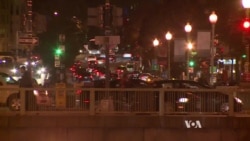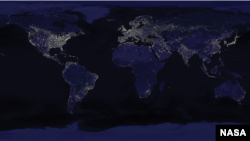For a really good look at the night sky, stay out of the city. Artificial light from street lamps, highways and buildings is so bright it can be seen from space and create an orange haze on Earth that hides the stars.
More than that, says Jim Dougherty, president of the International Dark Sky Association, light pollution can make you sick.
“Light pollution is outdoor lighting that is not serving the task that it is designed for," he says. "In fact it is either wasted or, worse, has harmful effects.”
According to his advocacy group, which works to raise awareness and take action against light pollution, excess artificial lighting disrupts sleep patterns, affects hormones and is linked to some cancers.
Dougherty says it also disturbs ecosystems, interferes with plants' growth cycle and plays a role in climate change.
“If we are burning natural gas or we’re burning coal, we’re causing global warming by sending light straight up into the sky,” he says.
There are examples of that near Dougherty's office, in Washington's popular Capitol Hill neighborhood where globe-style street lamps shed light in all directions. The problem is that they are spaced too close together, and, he says, represent "twice the number needed to make the sidewalks safe.”
In fact, Washington's lights are so bright they're visible from space. But passersby don’t seem to notice or care.
“The lighting makes me safe,” says one passing woman.
“It's comforting,” says her boyfriend. “The area around here is nice. It’s not too bright and it’s just the right setting for a romantic mood if you want to come out for dinner on 8th Street.”
But studies show that excess light doesn't make you safer. Dougherty says the lamps are more decorative than functional, sending light into the sky where it is not needed.
“If you double the amount of light, you do not increase the public safety benefit, but you do increase the cost,” he says. “You increase the energy use; you increase the climate impacts and health effects. So this is a classic example of over-lighting.”
Not far away, an apartment complex has installed both traditional floodlights that illuminate the grounds and walls, as well as more modern lamps that direct light downward.
Dougherty points out the dark façade of the building with the newer fixtures.
“There’s no light pollution going into their homes, so their health is being protected,” he says.
Motion sensors
Some cities are embracing the new lighting measures to curb waste and protect public health and may one day replace tall street lamps, Dougherty says.
There are signs of this alternatively lit future on the broad avenues near the U.S. Capitol, where shielded sidewalk lights aid passersby.
“Sidewalk lights are lower to the ground, dimmer, more efficient and get the job done without wasting all that money and all that energy,” he says. “They come on when there is someone there and then they turn off.”
Fixtures controlled by such devices can reduce lighting by 90 percent and still be effective. Dougherty hopes more people adopt new lighting technology, so they can one night look up and reclaim a sky of stars.







